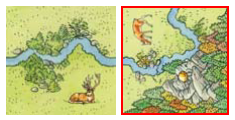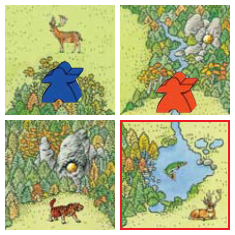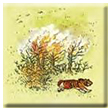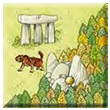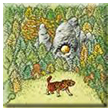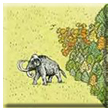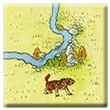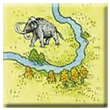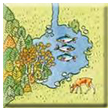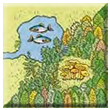Hunters and Gatherers Base Game
 |
You are reading the rules for this tile design. |
 | Read the following rules if your tiles look like this. Hunters and Gatherers v2 |
| If your tiles look like this, you have regular Carcassonne tiles. |  |
| If your tiles have a different design, then choose a game from Spin-offs. |  |
| Rio Grande Games | Z-Man Games |
General info and comments
Originally released by Hans im Glück in 2002.
Thousands of years before the present city of Carcassonne was built, the area was already populated. The people hunted wild animals, gathered berries and caught fish for their daily survival. Even today there remains fantastic cave paintings and archaeological finds from which we understand the lives of those days.
Contents
- 79 land tiles (including one starting tile with volcano)
deer (3 different pictures, but all deer count the same in the game)
mammoth saber-toothed tiger
- 12 bonus tiles
- 1 scoreboard
- 5 points tiles
- 30 tribe members in 5 colors
- 10 huts in 5 colors
- 10 green wooden discs
Overview
The players place the land tiles turn by turn. There are meadows, forests and rivers, on which the players may deploy their huts and tribe members to score points. Since points are awarded during the game as well as at the end, the winner is not known until after the final scoring.
Preparation
The starting tile with the volcano is placed in the middle of the table. The 78 other land tiles are mixed and placed face-down on the table in several stacks, so that each player can access them easily. Similarly, the 12 bonus tiles are mixed and placed face-down in a single stack. The scoreboard and the 50/100 points tiles are placed at the edge of the table.
Each player chooses a colour and receives the 6 tribe members and 2 huts of that color, placing one of the tribe members on the 0 field of the scoreboard. The remaining 5 tribe members and the 2 huts remain with the player as his or her supply.
The youngest player decides who will begin the game.
Playing the game
Play progresses in a clockwise fashion. The player whose turn it is carries out the following actions in the order given:
- The player must draw one new land tile from one of the stacks (not from the bonus stack) and place it.
- The player may take one tribe member or hut from their supply and deploy it to the tile just placed.
- If any forests or rivers are completed through the placement of the tile, they must be scored now.
1. Place a tile
As their first action, the player must draw a land tile from one of the stacks. The tile is then shown to the other players (so they can 'advise' the player about where to place it) and placed on the table. The player must take care to observe the following:
- At least one side of the new tile (with a red border in the examples below) must touch one or more tiles already in play. Corner-to-corner placement is not permitted. [1]
- Any meadow, river and forest segments must continue segments already in play.
- In the rare case that a tile cannot be placed anywhere, it is removed from the game, and the player draws another.
2. Deploy a tribe member or hut
When the player has placed the tile, he or she may deploy a tribe member or a hut. In doing so the following points must be observed:
- Only one tribe member or hut may be deployed each turn.
- The tribe member or hut must come from the player’s supply.
- The tribe member or hut may only be deployed to the tile just placed.
- The player must decide which part of the tile the tribe member or hut is deployed to.
A tribe member may be deployed as:
If the player deploys a tribe member as a hunter, he sets the figure flat on a meadow segment rather than upright. For details about this and the huts, see Huts
- There must be no other tribe member (not even one belonging to the same player) on the forest, river or meadow segments connected to the tile just placed. It does not matter how far away the tribe member is. The following two examples may help to explain:
It is still possible that several tribe members can exist on a contiguous territory (forest, river, grassland). How that happens is explained in A completed forest and the bonus tiles.
If a player runs out of tribe members and huts during the course of play, he or she may only place tiles. [2] But don't panic: you can also get tribe members back (see "Returning tribe members to their owners”). Huts, on the other hand, remain in play until the end of the game.
Now the player's turn is over, and it is the turn of the next player on the left. With the following exception: If a river or forest was completed through the placement of the tile, it must now be scored before the next player's turn begins. This does not apply to completed meadows, however. [3]
3. Scoring completed rivers and forests
A completed river
A river is completed when there is a lake or spring on each end, or when the river forms a closed circle. [4]
A player with the only fisherman on a completed river receives 1 point for each river segment. If the river has a lake on either or both ends, the player also receives 1 point for each fish.
Note: The player who finishes the river is usually the same player who scores points for the river. That need not be this way. It may happen that a player completes a river and another player collects the points because he has a fisherman there, as in the example above right.
All points are immediately recorded on the scoreboard. When the field '0' is reached or passed, the player takes a point tile and places it in plain view of all other players, with the number '50' face up. In this way it is clear to all that the player has already scored 50 points or more. If the player reaches or passes the field '0' again, they should turn the point tile over so that the number '100' is face up. It is quite possible that the player might lap the circuit a third time: then he or she should take another point tile and display it next to the first, the '50' face up.
A completed forest and the bonus tiles
A forest is completed when it is completely surrounded by meadows (i.e. there are no open sides where the forest can be expanded) and there are no gaps within the forest. There is no limit to how many segments a forest may contain. A player who has the only gatherer in a completed forest scores 2 points for every forest segment.
After scoring, the players look to see if there are any gold nuggets in the forest. If so, the player who completed the forest draws 1 bonus tile from the stack. [5] He or she then places the tile anywhere, following the normal rules for tile placement, and may also deploy 1 tribe member or hut on this tile. [6] If the placement of the bonus tile causes a feature to be completed, it is scored immediately. However, the player may not draw another bonus tile if he or she completes another forest with gold nugget (there is no chain reaction). When the bonus stack is used up, players no longer draw bonus tiles!
In summary:
- The player with a gatherer in a completed forest scores the points.
- The player who completes the forest draws the bonus tile.
- To the following example: if red completes the forest, he or she receives both the points and the bonus tile. If blue completes the forest, red scores the points and blue draws the bonus tile.
- The bonus tile may be placed in any valid location on the playing field.
- Regardless of how many gold nuggets a forest contains, only 1 bonus tile may be drawn.
- If the forest contains no gold nuggets, [7] a bonus tile may not be drawn.
The bonus tiles are described in more detail later in the rules.
What happens if there are several tribe members in a completed forest or river?
Through the wily placement of tiles it is quite possible for several gatherers to be in a forest or for several fishermen to be on a river. The points are then scored by the player with the most gatherers or fishermen. In the case of a draw, all players involved score the full number of points.
Example with several tribe members:
The newly-laid tile combines the previously separate forests. Afterwards, several gatherers occupy the same forest.
Note: Several tribe members in the same area does not contradict the rule: "There must be no other tribe member (not even one belonging to the same player) on the forest, river or meadow segments connected to the tile just placed." This rule applies only to the deployment of new tribe members! Here, however, we are dealing with connecting areas where tribe members are already deployed.
Returning tribe members to their owners
After a river or a forest has been completed and scored - and only then - any tribe members involved are returned to their owners. From the next turn onwards, the player can then use them again in whatever role he or she chooses.
Example of returning tribe members:
It is possible to deploy a tribe member, score immediately, and have the tribe member returned, all in the same turn. In this case, you must use the following order:
- Complete a forest or river with the new tile.
- Deploy a gatherer or fisherman.
- Score the completed forest or river.
- Return the gatherer or fisherman to your supply. [8]
Huts
Huts must always be placed on a river segment or a lake. A hut occupies an entire river system. A river system includes all connected river segments and is not interrupted by lakes. It ends only at a spring, or at the edge of the playing field. Huts are only scored at the end of the game.
When deploying a hut it should be noted: There must be no other hut (not even belonging to the same player) on the river system (this rule is similar to the one for deploying tribe members). Once deployed, huts remain on the river system for the duration of the game. [9]
Note: huts and fisherman do not prevent the placement of each other.
Huts examples:
The river system on the left belongs to blue. The river system on the right belongs to red.
The blue hut may be deployed.
The red fisherman may be deployed.
The meadow
Meadows are not scored. They serve only as places to deploy hunters. Once deployed, hunters remain on the meadow for the duration of the game. In order to make that clear, the hunters should be laid on their backs. This helps to distinguish them from gatherers and fisherman which can be returned during the game and redeployed. Hunters only score points at the end of the game (see "Final Scoring").
Example meadows:
All 3 hunters are on their own meadow. The forest, rivers, and the edge of the playing field separate the meadows from each other.
After the placement of the new tile, the meadows of the 3 hunters are joined to form one.
Note: The player who placed the tile may not deploy a hunter, since the meadow is already occupied by hunters.
The End of the Game
The game ends at the end of the turn in which the last land tile (not bonus tile!) is placed. The players remove all tribe members from incomplete forests and rivers from the playing field.
Incomplete forests and rivers are not scored. The huts on the rivers and the hunters in the meadows remain on the playing field for the final scoring.
Final Scoring
Scoring the huts
A player with the only hut on a river system receives 1 point for each fish in the river system. If several players have an equal number of huts on the same river system, each player receives the full score. If one player has a majority of huts, he or she alone receives the points. For the scoring of the huts, it is irrelevant whether a river system is completed or not. In this way, all huts are scored.
Scoring the hunters in the meadows
A player with the only hunter on a meadow receives the following points: 2 points for each deer, mammoth, and aurochs (which are only on the bonus tiles).
Sabre-toothed tigers are competing with you for food. They only hunt the deer; they do not dare approach a mammoth or an aurochs. For every sabre-toothed tiger on the meadow, a deer is not scored. To simplify the scoring, you can use the green wooden discs to cover tigers and deer in pairs. The remaining deer, as well as the mammoths and aurochs, are then added together. If a meadow contains more tigers than deer, there are no minus points.
If several players have the most hunters in a meadow, each receives full points. If one player has the most hunters, he alone receives the points. For scoring the hunters, it does not matter whether a meadow is completed or not. In this way, all hunters in meadows are scored. After scoring, the wooden discs are collected for use on the next meadow to be scored.
Meadow example:
Meadow A: 1 deer. Green scores 2 points.
Meadow B: 1 deer, 1 mammoth, 1 tiger. Yellow and Red will each score 2 points for the mammoth; the tiger eats the deer.
Meadow C: 2 deer, 2 mammoths, 1 aurochs, 1 tiger. Red has the most hunters. He alone scores 8 points (2 mammoths = 4 points, 1 aurochs = 2 points, 1 deer = 2 points).
Meadow D: 2 tigers, 1 deer. Blue receives no points, but no minus points either.
(For the sake of clarity, a tiger and deer in meadow C are covered with wooden green discs.) [10]
Description of Bonus Tiles
The bonus tiles must be placed in accordance with the normal rules. In addition, they have the following features:
On this meadow, all deer are scored.
Note: When deploying the hunter - as usual - there must not be any other hunters on the meadow!
Credits
Illustration: Johann Rüttinger
Tile Distribution
Total Bonus Tiles: 12
A = aurochs | D = deer | F = fish | M = mammoth | T = tiger | G = gold nugget
Total Points Tiles: 5
Footnotes
For Icons explanation and licensing please visit Icons page.
- ↑
 The RGG edition adds the following sentence here: “The edge of the table limits the playing area. Thus, a player may not place a tile past the edge of the table or move the playing area to place a tile that would have been past the edge of the table.”
The RGG edition adds the following sentence here: “The edge of the table limits the playing area. Thus, a player may not place a tile past the edge of the table or move the playing area to place a tile that would have been past the edge of the table.”
- ↑ The RGG edition places this sentence at an earlier point in the text.
- ↑
 This sentence is not present in the RGG edition.
This sentence is not present in the RGG edition.
- ↑
 The RGG edition adds the following sentence here: “There is no limit to the number of segments in a river.”
The RGG edition adds the following sentence here: “There is no limit to the number of segments in a river.”
- ↑
 Question: If I play a tile which completes more than one forest at the same time, do I get more than one bonus tile?
Answer: No. You can only ever get one bonus tile per turn, regardless of how many forests you complete, either with your initial tile or your bonus tile. Playing your bonus tile takes place in the same turn, so no extra bonus tiles are awarded.
Question: If I play a tile which completes more than one forest at the same time, do I get more than one bonus tile?
Answer: No. You can only ever get one bonus tile per turn, regardless of how many forests you complete, either with your initial tile or your bonus tile. Playing your bonus tile takes place in the same turn, so no extra bonus tiles are awarded.
- ↑
 The RGG edition adds the following sentence here: “If there is no legal place for the bonus card, the player discards it from the game and draws another.”
The RGG edition adds the following sentence here: “If there is no legal place for the bonus card, the player discards it from the game and draws another.”
- ↑
 The RGG edition adds the following erroneous remark: “(only possible in 2 segment forests)”
The RGG edition adds the following erroneous remark: “(only possible in 2 segment forests)”
- ↑
 The RGG edition adds the following sentence here: “It is even possible in the right circumstance for a player to do this with his placement of a land tile and again with the placement of a bonus card.”
The RGG edition adds the following sentence here: “It is even possible in the right circumstance for a player to do this with his placement of a land tile and again with the placement of a bonus card.”
- ↑
 The RGG edition adds the following sentence here: “After a player places a hut (or chooses not to), his turn ends and the next player takes his turn.”
The RGG edition adds the following sentence here: “After a player places a hut (or chooses not to), his turn ends and the next player takes his turn.”
- ↑
 The example given in the RGG edition differs slightly in that one tiger and one deer from Meadow 2 are covered instead.
The example given in the RGG edition differs slightly in that one tiger and one deer from Meadow 2 are covered instead.














